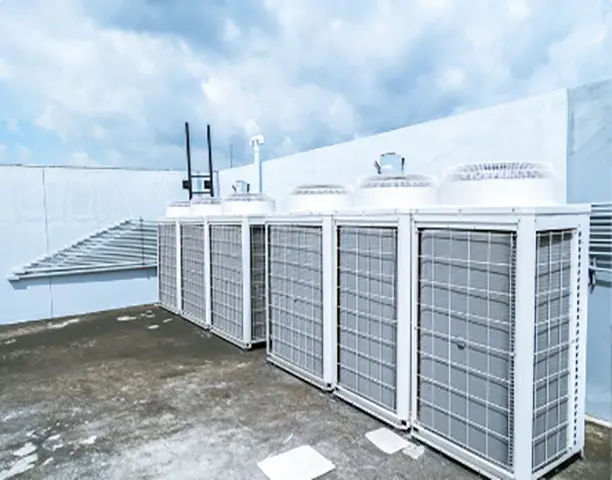What Are the Key Components of a High-Efficiency Copper Tube Aluminum Fin Heat Exchanger?

A high-efficiency Copper Tube Aluminum Fin Heat Exchanger relies on five essential components: copper tubes, aluminum fins, baffle plates, headers, and refrigerant. Each plays a critical role in optimizing heat transfer and ensuring durability. For instance, copper tubes provide superior thermal conductivity, while aluminum fins maximize surface area for efficient heat exchange. Together, these components create a compact, lightweight design ideal for limited spaces.
At Ningbo Senjun New Materials Co., Ltd., we specialize in crafting Copper Fin Heat Exchangers that excel in performance and reliability. Our products, designed for applications like refrigerators, freezers, and dehumidifiers, combine innovation with durability to meet diverse industry needs.
Key Takeaways
- Copper tubes move heat quickly because they conduct heat well. This makes them great for powerful heat exchangers.
- Aluminum fins add more surface area, helping heat move better. Good fin design keeps airflow steady and heat transfer strong.
- Baffle plates guide airflow and keep performance steady. They stop steam problems and help heat transfer work well in tough situations.
Core Components of a Copper Tube Aluminum Fin Heat Exchanger

Copper Tubes
Copper tubes form the backbone of a Copper Tube Aluminum Fin Heat Exchanger. Their exceptional thermal conductivity, approximately 400 W/m·K, ensures rapid and efficient heat transfer. This property surpasses other materials like aluminum and stainless steel, making copper ideal for high-performance applications. Copper's durability and natural resistance to corrosion further enhance its reliability, especially in humid or water-based environments. Additionally, the dimensions and configurations of copper tubes significantly influence performance. For example, smaller diameters allow for compact designs, while corrugated tubes improve fluid turbulence, boosting heat transfer efficiency.
Aluminum Fins
Aluminum fins play a critical role in maximizing heat exchange efficiency. By increasing the surface area, they facilitate rapid heat transfer between mediums. Aluminum's excellent thermal conductivity and natural oxide layer provide both high efficiency and corrosion resistance. Proper spacing and design of the fins are equally important. Closely spaced fins may restrict airflow, while overly wide spacing reduces contact with the surrounding air. At senjun, we ensure optimal fin spacing to balance airflow and heat dissipation, enhancing the overall performance of our heat exchangers.
Baffle Plates
Baffle plates are essential for directing airflow within the heat exchanger. They hold the copper tubes in place, preventing sagging during operation. More importantly, they guide the shell-side fluid flow along the tube field, increasing velocity and improving heat transfer efficiency. By preventing steam starvation effects, baffles ensure consistent performance even under demanding conditions.
Headers and Manifolds
Headers and manifolds distribute the refrigerant evenly across the copper tubes. This uniform distribution is crucial for maintaining consistent heat transfer throughout the system. At senjun, we design headers with precision to minimize pressure drops and ensure optimal refrigerant flow, contributing to the efficiency and reliability of our Copper Tube Aluminum Fin Heat Exchangers.
Refrigerant and Its Role
The refrigerant serves as the medium for heat transfer within the system. Its thermal performance, including heat capacity, directly impacts the efficiency of the heat exchanger. Selecting the right refrigerant is vital for compatibility with temperature and pressure requirements. Efficient refrigerants not only enhance heat transfer but also support compact equipment designs, aligning with environmental sustainability goals. At senjun, we prioritize refrigerants that balance performance with eco-friendliness, ensuring our products meet modern industry standards.
At Ningbo Senjun New Materials Co., Ltd., we combine innovation and expertise to manufacture high-quality Copper Tube Aluminum Fin Heat Exchangers. Our products cater to diverse applications, including refrigerators, freezers, and dehumidifiers, delivering unmatched performance and reliability.
Advantages of the Key Components
Superior Thermal Conductivity of Copper and Aluminum
The exceptional thermal conductivity of copper and aluminum forms the foundation of an efficient Copper Tube Aluminum Fin Heat Exchanger. Copper, with its high thermal conductivity of approximately 400 W/m·K, ensures rapid heat transfer. This property stems from its atomic structure, which allows free electrons to move quickly and conduct heat efficiently. Aluminum, while slightly less conductive at 237 W/m·K, complements copper by providing a lightweight and cost-effective solution. Together, these materials create a system that excels in both performance and practicality.
Lightweight and Cost-Effective Design
Aluminum's low density makes it an ideal choice for applications where weight is a concern. Its lightweight nature simplifies installation and reduces the overall load on supporting structures. Additionally, aluminum's abundance in nature makes it a cost-effective alternative to other metals. When paired with copper, which offers unmatched thermal performance, the result is a heat exchanger that balances efficiency, affordability, and versatility. For instance, at senjun, we leverage this combination to produce high-quality heat exchangers for refrigerators, freezers, and dehumidifiers.
Durability and Corrosion Resistance
Copper and aluminum are renowned for their durability and resistance to corrosion. Copper naturally resists oxidation, even in humid or water-based environments, ensuring long-lasting performance. Aluminum forms a protective oxide layer that shields it from corrosion, further enhancing its longevity. This combination minimizes maintenance requirements and extends the operational life of the heat exchanger, making it a reliable choice for demanding applications.
Enhanced Heat Transfer Efficiency
The synergy between copper tubes and aluminum fins maximizes heat transfer efficiency. Copper's superior conductivity ensures quick heat transportation, while aluminum fins increase the surface area for heat exchange. This design facilitates optimal heat dissipation and minimizes energy loss. At senjun, we optimize this combination to deliver products that meet the rigorous demands of modern cooling systems, ensuring both performance and reliability.
At Ningbo Senjun New Materials Co., Ltd., we take pride in designing Copper Tube Aluminum Fin Heat Exchangers that combine innovation, durability, and efficiency. Our expertise ensures that every product meets the highest standards of quality and performance.
How the Components Work Together for High Efficiency
Heat Transfer Process Between Copper Tubes and Aluminum Fins
The heat transfer process in a Copper Tube Aluminum Fin Heat Exchanger relies on the synergy between its core components. Here's how it works:
- Copper tubes, with their excellent thermal conductivity, transfer heat efficiently through conduction.
- Aluminum fins, designed to maximize surface area, enhance the transfer of thermal energy from the copper tubes to the surrounding air.
- The fins' design promotes airflow and increases surface contact, optimizing heat dissipation while minimizing energy loss.
This seamless interaction ensures that the heat exchanger operates at peak efficiency, even in demanding applications.
Role of Baffle Plates in Airflow Optimization
Baffle plates play a pivotal role in directing airflow within the heat exchanger. By guiding the fluid flow along the tube field, they increase velocity and enhance turbulence. This design ensures maximum contact between the fluid and heat transfer surfaces, boosting overall efficiency. Additionally, baffles prevent steam starvation and maintain consistent performance under varying conditions. At senjun, we prioritize precision in baffle plate design to ensure optimal airflow and heat transfer.
Importance of Proper Refrigerant Flow and Distribution
The refrigerant's flow and distribution significantly impact the heat exchanger's performance. Uniform distribution across the copper tubes ensures consistent heat transfer throughout the system. Uneven flow can lead to inefficiencies and hotspots. At senjun, we design headers and manifolds with precision to minimize pressure drops and maintain optimal refrigerant flow. This meticulous approach enhances the reliability and efficiency of our Copper Tube Aluminum Fin Heat Exchangers.
senjun’s Expertise in Optimized Heat Exchanger Design
At Ningbo Senjun New Materials Co., Ltd., we combine innovation and expertise to craft high-performance heat exchangers. Our designs incorporate advanced features to optimize efficiency and durability. For example:
| Feature | Description |
|---|---|
| Material | Lightweight aluminum fins for enhanced thermal efficiency. |
| Design | Compact design ideal for industrial and commercial applications. |
| Durability | Crafted to withstand harsh conditions, ensuring long-term performance. |
| Heat Transfer | Maximizes surface area for optimal heat exchange. |
| Energy Consumption | Minimizes energy consumption, leading to reduced operational costs. |
| Applications | Suitable for HVAC systems, refrigeration, and process cooling. |
By leveraging these innovations, we deliver products that meet the rigorous demands of modern cooling systems. Our commitment to quality ensures that every Copper Tube Aluminum Fin Heat Exchanger we produce exceeds industry standards.
The key components of a Copper Tube Aluminum Fin Heat Exchanger—copper tubes, aluminum fins, baffle plates, headers, and refrigerant—work together to achieve exceptional efficiency. Copper’s high thermal conductivity and aluminum’s lightweight nature form the foundation of this performance. Proper design, such as optimal fin spacing and precise refrigerant flow, further enhances heat transfer and durability.
Selecting the right materials is critical for performance. Factors like environmental conditions, mechanical strength, and cost must guide the choice. Copper, with its superior conductivity and corrosion resistance, remains unmatched for heat exchangers. Additionally, design elements like surface area and fluid flow configuration significantly impact efficiency.
At Ningbo Senjun New Materials Co., Ltd., we combine advanced materials and innovative designs to manufacture high-quality heat exchangers. Our products, used in refrigerators, freezers, and medical equipment, reflect our commitment to excellence. Backed by ISO9001 certifications, senjun ensures every unit meets rigorous quality standards, delivering reliability and performance across industries.
FAQ
What makes copper and aluminum the best materials for heat exchangers?
Copper offers superior thermal conductivity, while aluminum provides lightweight durability. Together, they ensure efficient heat transfer and long-lasting performance. At senjun, we optimize this combination for reliability.
How does senjun ensure the durability of its heat exchangers?
We use high-quality materials like corrosion-resistant copper and aluminum. Our designs undergo rigorous testing to meet industry standards, ensuring long-term performance in demanding applications.
Can senjun heat exchangers be customized for specific applications?
Yes, we tailor our products to meet diverse needs. Whether for refrigerators, medical equipment, or dehumidifiers, senjun delivers customized solutions with unmatched efficiency and quality.
At Ningbo Senjun New Materials Co., Ltd., we combine innovation and expertise to produce copper tube aluminum fin heat exchangers for various industries. Our commitment to quality ensures exceptional performance and reliability.


















